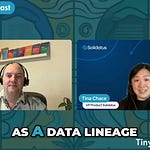Listen now on YouTube | Spotify | Apple Podcasts
A marketing leader spent over $1 million on a major industry summit this year. When asked about expected pipeline return, the conversation got uncomfortable fast. This is not uncommon.
Meanwhile, Rajeev Kozhikkattuthodi had his own AI reality check. He used to love using emojis in his business writing until AI overindexed on them and polluted content everywhere.[1] Now, if you use emojis in your writing, you’ll simply sound like a bot.
The problem in both cases wasn't the technology itself. It rarely is. It was the gap between having great insights and being able to act on them in a timely fashion.
About Rajeev Kozhikkatththodi
Rajeev Kozhikkattuthodi is the co-founder and CEO at Poexis, bringing 24+ years of experience in product engineering, sales, and the "messy bits" of building scalable businesses. He's helping growth marketers figure out how agentic AI can transform events, ABM, and inbound strategies from analysis engines into action drivers. Connect with Rajeev on LinkedIn.
In our conversation, we explore how B2B marketing leaders can move beyond endless data analysis, searching for the perfect insight, to drive measurable outcomes in 30-90 day cycles. You'll learn why most AI projects stall at the pilot stage, how to turn events from awareness plays into pipeline generators, and what leadership skills matter most in an AI-augmented world.
The mindset shift marketers need to make
Rajeev Kozhikkattuthodi has watched marketing teams build incredible analytical capabilities over the past decade. They can segment audiences down to specific individuals. They are able to track attribution across seventeen different touchpoints. They generate insights that would have been impossible just five years ago. The technology has come a long way; you no longer have to be an expert. Simply ask a question of your favorite tool and out comes an analysis and recommendation.
So, what’s the rub? Well, most of them are still missing their numbers.
"The number one mindset shift that marketers and sellers have to look at is how do I move from just analysis to agency," says Kozhikkattuthodi, CEO of Poexis.
The disconnect isn't about data quality or analytical sophistication. Marketing teams have those bases covered.[2] The problem is execution speed. You identify the perfect prospect segment, but someone still has to research each company manually. You know exactly what content performs best, but creating and atomizing it at scale while adapting it to hyper-specific audiences and companies remains problematic.
The problem lives in the space between insight and action. Picture if you will….a dimension where brilliant insights exist but never quite become reality. You've just crossed over into...the marketing Twilight Zone.
Kozhikkattuthodi calls this "analysis paralysis."[3] Teams generate insights they can't actually act on fast enough to matter.
Agentic AI changes significantly this dynamic. Instead of just telling you what to do, it does things on its own volition (if you want it to). It researches prospects while you sleep. It personalizes outreach sequences based on real-time triggers. It creates content variations, automatically tests them, and adapts them based on data-driven metrics.
The shift requires letting go of the idea that more analysis equals better results. Sometimes the 80% solution implemented tomorrow beats the perfect solution delivered next quarter. Rajeev recommends "leveling up" gradually, which he describes as a process of starting with low-risk automated actions, measuring results, then expanding autonomy based on what works. Think of it as training wheels for AI adoption. Start with automating research or basic content generation, then progress to more complex decision-making as you build confidence and guardrails. In other words, don’t try to boil the ocean; take baby steps.
Why most AI projects stall (and how to avoid it)
The MIT NANDA study that found 95% of AI projects fail wasn't telling marketing leaders anything they didn't already suspect. Most have a graveyard of pilot programs that showed promise in fancy vendor demos but never scaled. This connects directly to the marketing Twilight Zone problem. Teams can analyze endlessly, but turning insights into measurable business outcomes remains elusive.
The Poexis CEO sees three failure modes when he talks to marketing teams about their AI experiments.
First is the ROI articulation problem.[4] "The biggest reason most of these pilots around AI are stalling is the ability to look at ROI. The number one reason that most people get wrong is being able to articulate ROI at the P&L level," says Kozhikkattuthodi.
Teams get excited about productivity gains. Content creation is 10x faster. Research that used to take hours or days now takes minutes. But when the CFO asks how this translates to pipeline or revenue, the conversation stalls. Individual productivity doesn't automatically translate into business outcomes.
The second trap is what the Poexis founder calls "spray and pray at scale." AI makes content generation so easy that teams flood their channels. They create 100x more blog posts, social media content, and email campaigns that never make it past the spam filters and are simply ignored. But more content doesn't equal more qualified leads. Without a strategy behind the volume, you're just adding to the noise.
The third failure mode is analysis paralysis at the technology level. New AI models launch weekly. Teams spend months evaluating options instead of implementing solutions. Rather than waiting for perfect tools, Rajeev recommends picking a narrow use case, choosing a good enough technology, and starting within 30 days.
The companies that succeed focus on outcomes first. They identify specific business problems, set measurable goals, and use AI as a tool to achieve those goals rather than as a solution looking for problems.
Practical applications where agentic AI drives results
The martech landscape looks a lot like the patterns on Kozhikkattuthodi's and Sweenor’s Hawaiian shirts that they wore to the Podcast. You could spend five years analyzing every tool and still miss half the players. But while martech leaders debate technology stacks, buyers are changing how they want to be engaged.
"What we're seeing, somewhat ironically, is that buyers are really tuning out of all this digital noise. What they are preferring is really super relevant, personalized, and oftentimes in-person experiences," says Kozhikkattuthodi.
This shift creates opportunities for marketers willing to think beyond traditional automation.
Events: From awareness plays to pipeline generators
Take the marketing leader who spent over $1 million on that industry summit. Most event teams focus on attendance numbers and brand awareness. But Rajeev works with teams that set different goals. They set SMART goals like doubling pipeline output from the next event.
The change starts with pre-event research. Instead of generic outreach to drive attendance, agentic AI pulls intelligence from dozens of sources about target attendees. Not just what's in your CRM, but insights from recent company announcements, hiring patterns, and industry moves.
This research enables what Rajeev calls "experiential relevance." Instead of everyone seeing the same booth demo, each conversation gets tailored to what that specific company is trying to solve. Instead of generic follow-up emails, post-event outreach references actual conversations and next steps.
Here's how this works in practice: A cybersecurity company used AI to research 200 target attendees before a major conference. The system identified that one prospect's company had recently announced a cloud migration initiative. At the booth, the sales rep opened the conversation by asking about migration security challenges rather than delivering a standard product pitch. The prospect was impressed by the relevance and scheduled a follow-up call that same week.
"In the next 90 days, I'm gonna double my pipeline coming out of these events. That's the goal that I'm gonna set for myself my next event, and my team," says Rajeev.
ABM: Research and orchestration at scale
Account-based marketing typically breaks down at the research and activation phase. Sales teams want detailed intelligence on target accounts, but gathering it manually doesn't scale. Agentic AI can research hundreds of accounts simultaneously, identifying decision makers, recent business changes, and engagement opportunities.
The intelligence becomes actionable through orchestration. Instead of batch-and-blast campaigns, you can trigger personalized sequences based on specific account behaviors and characteristics.
Inbound: Staying human in the age of zero-click searches
HubSpot pioneered inbound marketing with the promise that great content would attract qualified leads. But search behavior has shifted. More searches now result in zero clicks as gen AI services and AI agents answer questions directly without sending users to websites.
Rajeev suggests building "agentic experience hubs" rather than traditional blog content. Instead of hoping people find your articles, create content specifically designed to be cited by AI research agents. This means more conversational formats, deeper context, and quantitative backing for claims.
The goal isn't driving traffic to your website. It's becoming the authoritative source that AI agents reference when prospects research your space.
What marketing leaders need to do now
The advice sounds counterintuitive coming from someone who spent decades in engineering and product development. But Kozhikkattuthodi believes the next few years will reward marketing leaders who focus less on technical skills and more on uniquely human capabilities.
"What really matters in the next couple of years is going to be more taste, less the hard skills.[5] To cultivate taste is very human and is surprisingly uncommon," says Kozhikkattuthodi.
Technical marketing skills have become table stakes. Most marketing teams can run attribution analysis, set up marketing automation, and interpret conversion data. But taste is harder to replicate or automate. It's knowing which campaign concept will resonate before you test it. It's recognizing when personalization feels creepy versus helpful. It's understanding which trends matter and which are just noise.
Cultivating taste requires consuming different perspectives, not just marketing content. Read what your customers read. Attend conferences outside your industry. Talk to people who disagree with your approach. And most importantly, talk to your customers and prospects as much as you can.
The second priority is relationship building. AI can research prospects and generate outreach, but it can't build genuine connections. Focus on strengthening relationships with sales teams, customers, partners, and leadership teams.
These relationships become strategic advantages when everyone has access to similar AI capabilities. Sales teams prioritize leads from marketers they trust. Customers engage with brands that understand their business beyond what's in public databases. Partners collaborate more deeply when relationships extend beyond transactional exchanges.
The third requirement is what Kozhikkattuthodi calls "bias toward action." Instead of spending quarters perfecting strategies, successful marketing leaders will rapidly experiment and iterate based on results.
Set 30-day goals. Pick one agentic AI application and implement it before the month ends. Measure results. Adjust approach. Repeat the cycle.
This approach works because AI technology evolves too quickly for long-term planning to remain relevant. The teams that succeed will be the ones that adapt fastest, not the ones with the most comprehensive strategies.
Escaping the marketing Twilight Zone
The marketing Twilight Zone where brilliant insights exist but never become reality doesn't have to be permanent. Agentic AI offers a way out, but only for teams willing to shift from analysis-first to action-first thinking.
What makes this moment different from previous waves of martech is the speed of change. Traditional approaches like lengthy pilot programs and comprehensive planning can't keep pace. The winners will be marketing leaders who develop what Rajeev calls "taste"—the human judgment to know which applications matter—combined with the courage to implement quickly and iterate based on results.
The irony is striking. In an age where AI can generate infinite content variations and analyze customer behavior at unprecedented scale, the most valuable marketing skills are becoming more human, not more technical. Building genuine relationships, making aesthetic judgments about what resonates, and maintaining bias toward action become competitive advantages precisely because they can't be automated.
Your next 30 days matter more than your next 30-month strategy. Pick one application—events, ABM, or inbound—and start building your "leveling up" muscle. The technology exists. The question is whether you'll use it to escape the analysis twilight zone or remain trapped in it.
Ready to move beyond analysis paralysis? Start with one agentic AI application this month. Pick events, ABM, or inbound. Set a measurable 30-day goal. Take action. Visit Poexis.
Podcast Highlights - Key Takeaways from the Conversation
[2:28] Defining Agentic AI "The crux of the difference that agentic AI brings to the table is the ability to take action, to do something, right? And I think that's really the sort of pivotal point where AI becomes a lot more than what helps you sort of predict, what helps you analyze."
[5:37] The Mental Shift Required "The number one mindset shift that marketeers and sellers and really sort of revenue leaders have to look at this is, how do I move from just analysis to agency."
[16:13] Why AI Projects Fail "The biggest reason most of these pilots around AI are stalling is the ability to look at ROI. The number one reason that most people get wrong is being able to articulate ROI at the P&L level."
[24:09] The Buyer Behavior Shift "What we're seeing, somewhat ironically, is that buyers are really tuning out of all this digital noise. What they are preferring is really super relevant, personalized and oftentimes in person experiences."
[29:01] Staying Human in AI Content "One of the most human ways to communicate, necessarily as copy, but in terms of conversations, is one of the best tips that you can use to drive inbound traffic, especially via agentic sources."
[36:53] Leadership in the AI Era "What really matters in the next couple of years is going to be more taste, less the hard skills. To cultivate taste is very human and is surprisingly uncommon."
Based on insights from Rajeev Kozhikkatthuthodi, co-founder and CEO at Poexis, featured on the Data Faces Podcast.
About David Sweenor
David Sweenor is an AI, generative AI, and product marketing expert. He brings this expertise to the forefront as the founder of TinyTechGuides and host of the Data Faces podcast. A recognized top 25 analytics thought leader and international speaker, David specializes in practical business applications of artificial intelligence and advanced analytics.
Books
● Artificial Intelligence: An Executive Guide to Make AI Work for Your Business
● Generative AI Business Applications: An Executive Guide with Real-Life Examples and Case Studies
● The Generative AI Practitioner's Guide: How to Apply LLM Patterns for Enterprise Applications
● The CIO's Guide to Adopting Generative AI: Five Keys to Success
● Modern B2B Marketing: A Practitioner's Guide to Marketing Excellence
● The PMM's Prompt Playbook: Mastering Generative AI for B2B Marketing Success
With over 25 years of hands-on experience implementing AI and analytics solutions, David has supported organizations including Alation, Alteryx, TIBCO, SAS, IBM, Dell, and Quest. His work spans marketing leadership, analytics implementation, and specialized expertise in AI, machine learning, data science, IoT, and business intelligence.
David holds several patents and consistently delivers insights that bridge technical capabilities with business value.
Follow David on Twitter @DavidSweenor and connect with him on LinkedIn.
[1] Sweenor, David. "The Great Enshittification of the Written Word." TinyTechGuides.com, August 23, 2025. https://tinytechguides.com/blog/the-great-enshittification-of-the-written-word/.
[2] Sweenor, David. "Digital Marketing in the Age of AI Disruption Part 2." TinyTechguides.com. June 9, 2023. https://tinytechguides.com/blog/digital-marketing-in-the-age-of-ai-disruption-part-2/.
[3] Sweenor, David. "Digital Marketing in the Age of AI Disruption Part 1." TinyTechGuides.com, June 2, 2023. https://tinytechguides.com/blog/digital-marketing-in-the-age-of-ai-disruption-part-1/.
[4] Sweenor, David. "Beyond the AI Hype: What 20% of Companies Get Right." TinyTechGuides.com. February 11, 2025. https://tinytechguides.com/blog/beyond-the-ai-hype-what-20-of-companies-get-right.
[5] Sweenor, David. "The 'Survival of the Nimblest' Strategy for AI Marketing Success." TinyTechGuides.com, July 1, 2025. https://tinytechguides.com/blog/the-survival-of-the-nimblest-strategy-for-ai-marketing-success/.










